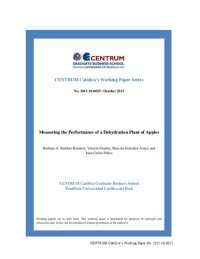
Ebook: Measuring the Performance of a Dehydration Plant of Apples
- Genre: Technique // Food Manufacturing
- Tags: Performance, Productivity, Efficiency Analysis, Processed Food Industry, Dried Apples, Data Envelopment Analysis
- Series: CENTRUM Católica’s Working Paper Series
- Year: 2015
- Publisher: Pontificia Universidad Católica del Perú (PUCP) - CENTRUM
- City: Lima
- Language: English
- pdf
Given the importance of the Chilean dried-fruit market and the characteristics of the
industrial process of dehydration, it becomes imperative for companies to measure the
efficiency of their production processes in order to identify critical areas and take the
necessary actions to improve them. Hence, the present work performs an efficiency analysis
for the production of dried apples in a plant of the Maule region, Chile. The methodology
used is Data Envelopment Analysis, considering both discretionary and non-discretionary
variables. The results indicate that the application of the model without non-discretionary
variables shows higher efficiency indices than the model with non-discretionary variables.
Additionally, the efficiency analysis results, segregated by variety, origin, and fruit type,
indicate that the selection of these segregations could be used to increase the production or
generate higher efficiencies. Finally, the technological change in the same plant is analysed
through the Malmquist index. The findings of this research could help improve the decisionmaking process of managers concerned with the efficient use of resources within the
company.
Keywords: Performance; Productivity; Efficiency Analysis; Processed Food Industry; Dried
Apples; Data Envelopment Analysis
industrial process of dehydration, it becomes imperative for companies to measure the
efficiency of their production processes in order to identify critical areas and take the
necessary actions to improve them. Hence, the present work performs an efficiency analysis
for the production of dried apples in a plant of the Maule region, Chile. The methodology
used is Data Envelopment Analysis, considering both discretionary and non-discretionary
variables. The results indicate that the application of the model without non-discretionary
variables shows higher efficiency indices than the model with non-discretionary variables.
Additionally, the efficiency analysis results, segregated by variety, origin, and fruit type,
indicate that the selection of these segregations could be used to increase the production or
generate higher efficiencies. Finally, the technological change in the same plant is analysed
through the Malmquist index. The findings of this research could help improve the decisionmaking process of managers concerned with the efficient use of resources within the
company.
Keywords: Performance; Productivity; Efficiency Analysis; Processed Food Industry; Dried
Apples; Data Envelopment Analysis
Download the book Measuring the Performance of a Dehydration Plant of Apples for free or read online
Continue reading on any device:

Last viewed books
Related books
{related-news}
Comments (0)